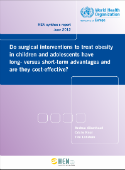Do surgical interventions to treat obesity in children and adolescents have long- versus short-term advantages and are they cost-effective?

Download
Summary
The issue
During the last decades the prevalence of childhood and adolescent obesity in Europe has grown. Although it is possibly levelling off in some areas of Europe, the scale of childhood obesity and its associated morbidities and costs remains considerable. Obese children and adolescents are more likely than others to have risk factors for cardiovascular diseases, experience other health conditions associated with increased weight, such as type 2 diabetes and sleep apnoea, perform poorly at school and suffer psychological distress. Clear evidence for successful and cost-effective non-surgical strategies for treating childhood obesity is lacking, leading the medical profession to turn increasingly to surgical treatment options. While bariatric surgery is established as a safe and effective alternative with well-defined risks for severely obese adults, little of quality has been published on its use in children, with their unique metabolic, developmental and physiological needs. Evidence is needed on the effectiveness and cost–effectiveness of surgical treatment in order to support policymakers and guide future research.
Findings
In the context of a general lack of effective tools for primary prevention or behavioural treatment of obesity, surgical treatment may be advocated as a preferred and cost-effective solution for certain children and adolescents. However, the role of bariatric surgery in the treatment of obese children or adolescents is controversial. The concerns about surgery to treat obesity in young populations include:
-
obtaining informed consent from minors;
-
timing of intervention;
-
whether or not surgery is cost-effective;
-
how to ensure healthy growth through to adulthood; and
-
what support services are needed after surgery: compliance with the postoperative nutrition regimen, and attendance at appointments for long-term follow-up and care.
These concerns underscore the importance of well-designed and well-evaluated research studies on the effectiveness of treatment options for obesity in child populations. As demonstrated in the current evidence review, the few studies that exist are primarily retrospective or observational, and underpowered. The indications for medical and surgical treatment in overweight and obese children are still not well defined. There is no clear indication of the cost–effectiveness of surgical interventions for paediatric obesity. There is very limited evidence available to adequately estimate long-term safety, effectiveness, cost–effectiveness or durability of bariatric surgery in growing children.
Policy considerations
-
Although based on methodologically limited and underpowered studies, the existing evidence suggests that bariatric surgery in severely obese adolescent results in significant weight loss and improvements in comorbidities and quality of life.
-
Postoperative complications, (both physical and psychological), compliance and follow-up may be more problematic in adolescents than adults, and long-term data on safety, effectiveness and cost remain largely unavailable.
-
Simple adoption of adult bariatric surgery guidelines for use in younger age groups would overlook the contrasting metabolic, developmental and psychological needs of children and adolescents and could result in the inappropriate use and/or overuse of weight loss surgery. Conversely, delaying treatment and allowing comorbid conditions to progress could be equally or more disadvantageous.
-
An academic approach to child and adolescent bariatric surgery is warranted until further long-term prospective studies on the subject are conducted.
-
Controlled clinical trials to test the safety and efficiency of surgical approaches to address obesity in young people are required, as well as renewed efforts at developing effective approaches to preventing and treating excess weight gain in children in order to inhibit progression to greater degrees of obesity.



